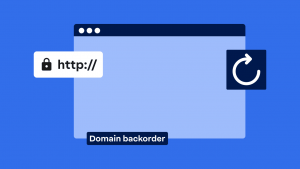Key takeaways:
- A domain name matters because it adds credibility to your web presence and protects your brand by ensuring no one else can use that name.
- When you register your domain name, you’re not actually “buying” it, but instead renting the right to use it for a set period, typically 1 to 10 years, requiring periodic renewal.
- As your business grows, tools like email, website builders, and marketing services can help expand your reach.
Building a brand for your online business? Securing a domain name is one of the first things you want to do. But navigating the domain registration process may feel overwhelming.
This article will guide you through the process of registering (or buying) a domain name. If you’re a beginner planning to create a website or a small business owner who wants to expand online, this guide has got you covered.
What is a domain name?
A domain name is an online address, like “yourwebsite.com.” When typed into a browser, it directs people to a website and allows you to build a site for people to land on. You gain ownership to an internet address after registering a domain name.
While many people say they “buy” a domain name, you’re actually registering it. This means you’re renting the exclusive right to use that specific internet address for a set period and renew it periodically to maintain that right. Think of it like leasing a property—you pay to use the domain name for a set period (usually 1–10 years), and you must renew it to keep ‘ownership’.
Why registering a domain name is important for your business
A domain name matters because it adds credibility to your web presence and protects your brand by ensuring no one else can use that name. Having a domain name is important in establishing yourself or your business online. A domain name:
- Establishes online credibility. A registered domain name gives your business a professional presence compared to the free ones that some domain registrars offer. Free domains like “yourbusiness.wordpress.com” appear more like a personal blog than a business website.
- Builds brand identity and recognition. A custom domain boosts your brand identity and makes it more memorable.
- Protects your brand online. Securing your domain and similar names prevents competitors or cybersquatters from claiming them. Cybercriminals could harm your reputation by using the domains for scams or siphon web traffic off your site.
- Gives you control over your digital assets. A registered domain can set up branded emails such as “[email protected],” link to a custom website, and manage page redirects on your own terms.
- Increases customer trust. A domain name can help shape how customers see your business and influence their buying decisions and loyalty. Custom domains reinforce you brand identity and can improve customer perception.
Who is ICANN and what do they do?
The Internet Corporation for Assigned Names and Numbers (ICANN) is a non-profit organization that coordinates the global Domain Name System (DNS). They oversee domain registrations and ensure every domain name is unique and functions correctly.
They don’t sell domain names directly, but they oversee the registrars that do, and they make sure the whole system runs smoothly, securely, and fairly.
Here’s what they do:
- Maintain the domain name database. ICANN oversees the system that tracks who owns which domain. This is where the WHOIS directory comes from, a public record that shows the contact information of domain owners (unless privacy protection is enabled).
- Resolve domain disputes. When two parties claim rights to the same domain, ICANN’s policies help determine who has a valid claim. This is especially useful in trademark conflicts or domain squatting cases.
- Accredit registrars. ICANN approves registrars that meet their standards for security, transparency, and compliance. Using an ICANN-accredited registrar means you’re working with a provider that follows global rules and best practices.

How to register a domain name in 5 steps
Registering a domain has important steps that ensure security and your ownership rights. We’ll help you do it right through this guide.
- Choose a domain name
- Check for trademarks and brand conflicts
- Verify domain availability
- Select a trusted domain registrar
- Purchase and register your domain name
1. Choose a domain name
Before buying a domain, think of a name that best represents your online identity, whether for a business, a personal brand, a blog, or a portfolio. Come up with a shortlist in case your first choice isn’t available.
When choosing a domain name, make sure it’s:
- Relevant and memorable. Choose a name that reflects your brand, content, or purpose. Consumers should also easily remember, spell, and pronounce the domain.
- Short and simple. Avoid complex or long strings of words. Make it easy for customers to type your address.
- Unique and original. Choose a unique domain name that differs from existing brands or websites. This reduces legal risks and makes your site easier to find.
- Keyword-friendly (optional). If you want to improve search engine visibility, you can include relevant keywords in your domain name but it naturally and sparingly.
You can use an AI domain generator if you struggle to develop name ideas. Just describe your business, and it will suggest names that match your brand and goals.
Determine your TLD
A top-level domain (TLD) or domain extension is the part of a domain name that comes after the second dot, like .com, .org, or .net. These influence how people view your website and interact with your business.
The most common and trusted option is .com. It works well for most businesses and is easy for people to remember. If .com isn’t available, .net is a solid backup, especially for tech-related sites. Then, there is .org, often used by non-profits or community-focused projects.
You can also choose location and industry-specific top-level domains. For example:
- Country code TLDs like .ca, .uk, or .au work well for local businesses
- Niche TLDs like .shop, .tech, or .design help show what your website is about
- Restricted TLDs like .gov or .edu that signal you belong in such institutions (as long as you get approval from the TLDs’ governing organization)
Keep in mind that some TLDs cost more than others, and not all are equally trusted by users. Before registering, check if third parties own similar domain with a different TLD. If that existing site has low-quality or unrelated content, using a similar name could negatively impact your brand.
Ultimately, your TLD should align with your goals and target audience. Always check the renewal pricing, availability, and the TLD’s reputation before finalizing your choice.
2. Check for trademarks and naming conflicts
Ensuring your domain name isn’t trademarked or used by another business will save time and money.
Use the United States Patent and Trademark Office USPTO’s tool to check trademarked names. International equivalents like the European Union Intellectual Property Office (EUIPO) or the UK Intellectual Property Office (UKIPO) can help if you’re in the EU and UK respectively.
3. Verify domain availability
Use a domain registrar’s domain name search tool to check if your desired name is available. These tools tap into the WHOIS and RDAP databases, public directories of registered domain names.
If it’s taken, consider name variations or alternative domain extensions. If you find it hard to come up with a different name, you can purchase the registered domain directly from the owner or through a third party.
How to buy a domain name from a third party
Many domain names are owned by individuals or businesses willing to sell for the right price. The process typically involves:
- Looking up the current domain owner (via WHOIS or domain marketplaces)
- Reaching out directly or using a domain broker
- Negotiating a price and completing the transaction securely
Some domain names might be listed on marketplaces like Sedo or Flippa. For a full breakdown, check out our in-depth guide on how to buy a taken domain name.
4. Select a trusted domain registrar
Choose an accredited registrar that offers features that provide long-term security for your domain, like domain privacy protection, trademark protection, domain transfer lock, and domain expiration protection.
Also, look for companies with a solid reputation, easy domain management tools, and reasonable renewal rates. Popular registrars that fit these criteria include GoDaddy, Namecheap, Network Solutions, and Squarespace Domains.
5. Purchase and register your domain name
Once you have your name and registrar, these steps will guide you through the purchase process:
1. Search for your domain. Visit a trusted registrar’s domain page and enter your desired domain name into the search bar. This verifies availability.

2. Add your domain to the cart. Add the domain to your cart to proceed to the next step. You can select multiple domains or different TLDs (like .com, .net, .co, etc.) to protect your brand.
3. Choose your registration term. Decide how many years you want to register the domain for. Most registrars offer discounts for multi-year purchases. If you’re building a long-term business, consider longer terms to avoid renewal headaches.
4. Review add-ons. During checkout, you’ll encounter optional services that enhance your domain name registration. Network Solutions provides several add-ons that you might find beneficial:
- Private registration: Keeps your personal information hidden from public WHOIS databases.
- Web hosting: Provides space to build and host your website.
- Email services: Sets up professional email addresses using your domain.
- SSL certificates: Secure your website with HTTPS encryption protocol.
These add-ons are optional, so review them carefully. You can skip the ones you don’t need and add them later.

5. Enter your contact information. Provide accurate contact details, including your name, address, phone number, and email address. ICANN requires this information for all domain registrations. This information will be visible in the public WHOIS database unless you purchase privacy protection.
6. Complete payment and finalize registration. Review your order total, enter your billing details, and complete the purchase. After payment, you’ll receive a confirmation email with your registration details and a request to verify your email address. Make sure to complete this verification step to activate your domain.

7. Enable auto-renewal (optional but recommended). Domains expire if you don’t renew them. Enabling auto-renewal ensures your domain stays active without interruption, especially if it’s critical to your business.
Note: Steps vary per registrar. When you buy a domain name, you have the right to use it, but you don’t own it forever. You’re just leasing it for a period as long as you keep renewing it. If your domain violates someone else’s trademark, they may be able to claim it from you.
What to do after getting a domain name?
After you successfully register a domain name, there are a few things you can do to maximize your domain’s potential. Here’s what to do:
- Connect your domain to your website: Update the DNS settings in your domain registrar dashboard to point your domain to your website’s hosting.
- Set up email routing: If you plan to use your domain for email (e.g., [email protected]), configure email routing. Most email providers like Google Workspace or Microsoft 365 offer straightforward guides for this.
- Integrate your domain across your business materials: Consistently use it across all your online and offline business assets to build a professional brand presence. Consider adding it to:
- Your email signature
- Business cards
- Social media profiles
- Google Business Profile
- Consider digital marketing. As your business grows, digital marketing can help you reach more customers by improving your online visibility and appeal. You can try our comprehensive digital marketing services such as pay-per-click (PPC) and search engine optimization (SEO) to support your growth.
- Secure and maintain your domain. Take a few steps to keep your domain secure and active:
- Turn on auto-renewal: Prevent your domain from expiring unintentionally.
- Enable domain privacy: Protect your personal information from being publicly accessible.
- Set up email forwarding: If needed, forward emails from your domain to another email address.
- Review optional security features: Explore additional security options like SiteLock to further protect your website.
These small actions go a long way in keeping your domain protected and your online presence running smoothly.
Common domain registration mistakes to avoid
To make the most of your domain, here are the most common mistakes you need to avoid in the domain registration process:
- Choosing a complicated name. Avoid hard-to-spell or long domain names. They’re tough to remember and prone to errors. Stick with simple and clear names for better user experience.
- Ignoring renewal. Set up auto-renewal or keep a close watch on your domain’s expiration date—losing it can hurt your business and create unnecessary stress. Auto-renewal helps keep your domain active, but adding Domain Expiration Protection (DEP) with Network Solutions provides even more security. If auto-renewal fails due to a payment issue, like an expired credit card, DEP keeps your domain safe for up to a year, so you never have to worry about losing it unexpectedly.
- Skipping keyword research. Domains with relevant keywords can help users understand what your site is about. While it’s not the only factor for SEO, a clear, descriptive name tied to your niche can still give your brand a boost.
- Not checking for trademarks. Before registering a domain, ensure it doesn’t conflict with existing trademarks. Using a trademarked name could lead to legal issues, and you may be forced to relinquish the domain.
- Skipping domain privacy protection. When you register a domain, your contact details can appear in the public WHOIS database. Without privacy protection, spammers or scammers can easily find your info. Network Solutions offers domain privacy as an add-on, so you can keep your personal data private and protect your domain from unwanted attention.
Frequently asked questions
Domain prices usually start around $10–$20 per year, but some registrars offer discounts as low as $1 for the first year. The cost depends on the domain extension (like .com, .tech, or .design) and whether the domain is already owned. Keep in mind that renewal prices are often higher than first-year deals.
If you forget to renew your domain, it won’t vanish right away — but it will stop working. Most registrars give you a short grace period to renew it. If you miss that window, someone else could buy it. To avoid losing your domain, turn on auto-renewal or use Domain Expiration Protection from providers like Network Solutions.
Not for most domains. You can register global extensions like .com, .net, or .org from anywhere. But country-specific domains (like .uk or .ca) may require you to live in or have a presence in that country.
No, you can’t edit a domain name once it’s registered. If you want a different name, you’ll need to register a new domain and redirect your website and domain specific email address.
Not usually. Domains are paid yearly, but some hosting companies include a free domain for the first year when you buy a hosting plan. Just check the renewal cost — you’ll pay for it after the first year.
You can register a domain for up to 10 years at a time, depending on the registrar. Most people start with 1–2 years, then renew as needed. Enabling auto-renew helps make sure you don’t lose it by accident.
Some domains cost more because they’re short, brandable, or use popular keywords. These are called premium domains, and prices can range from a few hundred to thousands of dollars depending on demand.
A domain name is your web address like yourname.com. Hosting is the service that stores your website files and makes them visible online. You need both to run a website. Some companies offer domain and hosting as a package.
Register your domain name with Network Solutions
Securing your domain name is a big step toward building a professional, trustworthy online presence. Whether you’re launching a new idea, building a business, or rebranding, having the right domain sets the foundation for everything that comes next.
With Network Solutions, the process is quick and user-friendly—making it easy to get started without the hassle. Plus, as your needs grow, you’ll have access to tools like email, website builders, and online marketing services to support your next steps.
Take the first step—register your domain with Network Solutions and start building your presence today.




